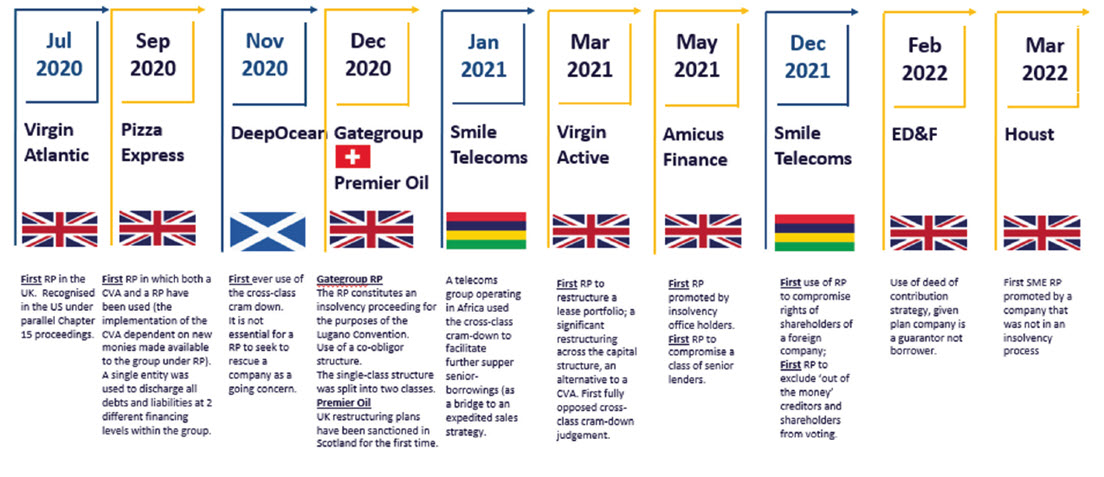The UK Part 26A restructuring plan was introduced in the UK over two years ago. It draws upon features of the well-tested scheme of arrangement, a court supervised procedure under Part 26 of the UK Companies Act 2006. Despite being similar to the scheme, it has many distinctive features.
Financial Difficulties Test and Cross-Border Recognition
One of the main differences between a restructuring plan and a scheme of arrangement is eligibility criteria. Schemes are available to solvent and insolvent companies, and restructuring plans can only be used by companies that have encountered, or are likely to encounter, financial difficulties. As a result, cross-border recognition of UK restructuring plans, which might be regarded to be insolvency processes (especially those that use the new cross-class cram down mechanism) in certain circumstances, might be different to the recognition of schemes. The general rule is that to the extent that UK restructuring plans compromise debt governed by English law, they would be recognised in the European Union under Regulation (EC) No 593/2008 of the European Parliament and of the Council of 17 June 2008 on the law applicable to contractual obligations (Rome I). If the governing law is non-English, the legal analysis becomes more complex.
Court-Supervised Process
Procedurally, restructuring plans are very similar to schemes of arrangement. Typically, the company will prepare a plan proposal and apply to court for approval to convene meetings of the company’s creditors and members. The restructuring plan can also be proposed by creditors and shareholders, although this might be a challenging task given that they have limited access to information that is available to the company.
An uncontested restructuring plan can be finalised and approved by the court in as little as eight weeks. Implementation of the plan involves two court hearings (a convening hearing and a sanction hearing). Creditors are presented with the opportunity to make representations at the court hearings. If the court is satisfied the convening conditions have been satisfied (including the eligibility criteria, the classes have been formulated correctly, and there are no jurisdictional issues), it will make an order convening the creditor and member meetings. The meetings will then be held and votes recorded. If creditors and members approve the plan (75% in gross value of debt or equity in at least one class that would receive a payment, or have a genuine economic interest in the plan company, no numerosity test) at the sanction hearing, the court will decide, at its absolute discretion, if the plan should be sanctioned. Once the restructuring plan is approved by the court, all stakeholders are provided with finality.
Cross-Class Cram Down Mechanism
The main new and incredibly powerful feature of the restructuring plan is the cross-class cram down mechanism, which changed the way many UK restructurings are planned and implemented. As a result, the UK restructuring landscape now has something in common with the US Chapter 11 model. Having said that, there are many differences between the UK restructuring plan and US Chapter 11 debtor-in-possession process, which is a formal insolvency process. By contrast, UK restructuring plans take effect under the UK Companies Act 2006 (rather than under the UK Insolvency Act 1986). Similar to most Chapter 11 proceedings, UK restructuring plans typically allow management to remain in place (there is no trustee or another insolvency practitioner appointed by the court to supervise the restructuring steps, although a plan supervisor could be built into the terms of the plan if required in an appropriate case).
The UK court may exercise its discretion and sanction a restructuring plan notwithstanding its rejection by one or more classes of the plan company’s creditors or members if:
- None of the members of the dissenting class would be any worse off than they would be in the relevant alternative (often a formal insolvency process).
- The plan has been approved by at least 75% in value of at least one class of creditors or members that would receive a payment, or have a genuine economic interest in the plan company, in the relevant alternative.
Consequently, a single in-the-money class (even a junior class) could drive the restructuring plan negotiations, and such a plan could be sanctioned by the court even though the other classes vote against the plan. This is a major change to the UK restructuring landscape where the alternative restructuring tool, a scheme of arrangement, can be blocked by dissenting classes of scheme creditors (even if the dissenting classes are out of the money).
How Can Restructuring Plans Tackle Over-Leveraged Balance Sheets?
Highly leveraged companies can be sensitive to economic declines. Lenders might not provide further funding to highly leveraged businesses, and as a result it might be more difficult for them to refinance existing debt. One of the options a company has to reduce its financial leverage is to increase the amount of equity capital. However, investors might refuse to inject more money to an over-leveraged business. The restructuring plan is well suited to help over-leveraged companies with complex financial arrangements address challenges associated with the emergence from the Covid-19 pandemic, high inflation, and rising interest rates. The restructuring plan can be utilised in the following ways (as these companies have done):
- A solvent recapitalisation (Virgin Atlantic RP)
- A combination of debt-for-debt and debt-for-equity swaps (PizzaExpress RP)
- A solvent wind-down (DeepOcean RP)
- M&A – share merger between Premier Oil and Chrysaor Holdings Ltd and the reorganisation of Premier’s existing debt and cross-currency swaps (Premier Oil RP)
- Raise new money (ED&F Man RP, Smile Telecoms RP)
- Reschedule debt, restructure lease, and inject new money (Virgin Active RP)
- Amend and extend the senior facilities agreement and terms of bonds governed under Swiss law (Gategroup RP)
- Exit from administration to allow the company to operate as a going concern and avoid the need to file for liquidation (Amicus Finance RP)
- A compromise of the company’s liabilities and alteration of the company’s equity structure to facilitate the injection of new money (Houst RP)
Arguably, restructuring plans are more sponsor friendly than schemes of arrangement because the sponsor can retain some or all equity or inject new funds as part of the restructuring process. It is possible to impair higher ranking creditor classes and give some value to the sponsor under a plan because there is no absolute priority rule under English law, although the requirement that the plan be fair and equitable must also be considered.
Will Restructuring Plans Be Used More Often in the Future?
Restructuring plans will almost certainly be used more in the future, especially by SMEs following the Amicus Finance and Houst restructuring plans. So far this year, the use of restructuring plans has been limited to cases where the plan company has needed to resort to cross-class cram down (Houst RP and ED&F Man RP) or exclude out-of-the-money stakeholders from voting (Smile Telecoms RP).
Release date of RP Practice Statement Letter


